Epidemiological trends of women's cancers from 1990 to 2019 at the global, regional, and national levels: a population-based study
- PMID: 34233747
- PMCID: PMC8261911
- DOI: 10.1186/s40364-021-00310-y
Epidemiological trends of women's cancers from 1990 to 2019 at the global, regional, and national levels: a population-based study
Abstract
Background: Every year around the world, more than 2 million women are diagnosed with breast cancer and genital tract cancers. However, there are rare studies comprehensively describing the global and regional trends of incidence and mortality of women's cancers.
Methods: To study the burden and trend of women's cancers, we conducted this cross-sectional study based on the epidemiologic data of Global Burden of Disease 2019. In this study, female patients with breast cancer, cervical cancer, ovarian cancer, and uterine cancer worldwide from 1990 to 2019 were involved. The incidence, death, and disability-adjusted life-year (DALY) were used to measure the outcomes of women's cancers. The estimated annual percentage change (EAPC) was calculated to assess the changing trend of cancer burden.
Results: Among the four women's cancers, the burden of female breast cancer was highest. During the past 30 years, the incidence, death, and DALY of female breast cancer kept increasing worldwide. In most regions especially developing countries, cervical cancer was the second most common women's cancer. At the same time, ovarian cancer and uterine cancer occurred less frequently. Generally, the age-standardized incidence rates (ASIRs) of breast cancer, ovarian cancer, and uterine cancer were positively correlated to sociodemographic index (SDI) value. In contrast, the ASIR of cervical cancer was negatively correlated to SDI value.
Conclusions: Our study indicates that the incidence and mortality of women's cancers have geographical variations and change along with SDI value. The results might be helpful to policy-makers to allocate healthy resources to control women's cancers.
Keywords: Breast cancer; Cancer epidemiology; Cervical cancer; Gynecological cancer; Ovarian cancer; Uterine cancer.
Conflict of interest statement
The authors declare no conflict of interest.
Figures
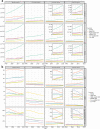
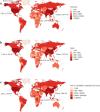
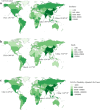
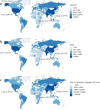
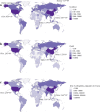
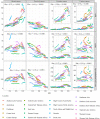
References
-
- Fitzmaurice C, Abate D, Abbasi N, Abbastabar H, Abd-Allah F, Abdel-Rahman O, et al. Global, Regional, and National Cancer Incidence, Mortality, Years of Life Lost, Years Lived With Disability, and Disability-Adjusted Life-Years for 29 Cancer Groups, 1990 to 2017: A Systematic Analysis for the Global Burden of Disease Study. JAMA Oncol. 2019;5:1749–68. doi: 10.1001/jamaoncol.2019.2996. - DOI - PMC - PubMed
Grants and funding
LinkOut - more resources
Full Text Sources
Miscellaneous

